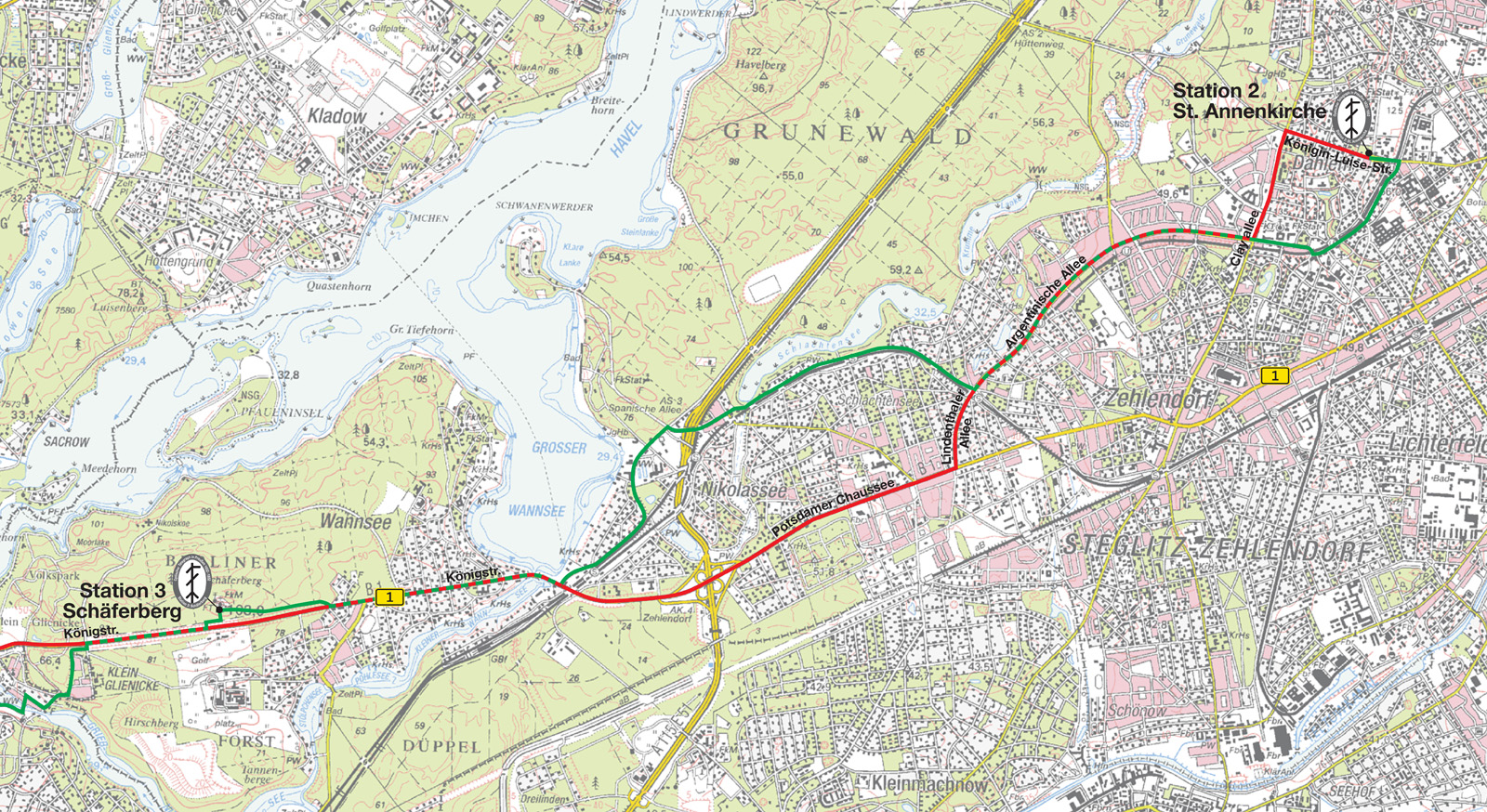Berlin-Wannsee station
- Wannseebahn ( KBS 200.1 )
- Wetzlar Train ( KBS 200.7, 201, 207)
- Graveyard orbit ( decommissioned)
I7i12i13i15i16i16i18i20
The station is located in Berlin-Wannsee district of Berlin Wannsee near the Great Wannsee and is an important transport hub. It is located in the southwest of Berlin in the district of Steglitz -Zehlendorf, and is located at an intersection of the Wannsee railway and the Wetzlar train near the Havel and the AVUS motorway.
To the north, the routes towards Grunewald and Steglitz, in the south branch to Dessau and Potsdam.
The train station is included in the train station category 2 of the DB Station & Service.
- 2.1 long-distance, regional and local transport
- 2.2 Bus and Ferry
- 2.3 Line overview
History
Taken together with the June 1, 1874 in Operation Wannseebahn, Berlin's first suburban stretch of Zehlendorf to Griebnitzsee, the new station as station " Wannensee " was opened. 1878, the name was changed to " Wannsee ". This name was only for the platform of the Wannsee train, the location of the Wetzlar train station platform was called " Drei Linden ". It was not until 1888, the railway facilities were expanded and merged and the whole station now was called " Wannsee ". At that time, two new platforms emerged with the typical cast iron pillars of the Prussian State Railways as carriers of the platform canopy is designed as a gable roof.
The first station building was used from 1878 (1874? ) Of discarded wooden Kaiserpavillon the Vienna World Exhibition of 1873, had breakfast together in the Emperor Wilhelm I, Emperor Franz Josef I and Tsar Alexander II. The pavilion was approximately on the site of today's restaurants Loretta and was canceled in 1927 for a new platform, after they had already started to build a larger station building.
The train station touched since 1891 with the introduction of the Berlin suburb Tariff both the suburban trains from Potsdamer Bahnhof Wannsee and the coming of the light rail commuter trains the Wetzlar train, the south Wannsee not part of the suburban fare. In long-distance trains Wannsee was just stop for long-distance trains on the Wetzlar train to Dessau.
On June 13, 1913, an additional route branch was opened. The graveyard orbit to Stahnsdorf Reichsbahn. This track was built at the expense of the Evangelical Church and should allow Berliners to visit the cemetery located in Stahnsdorf Southwest. She was also involved in the suburban fare. It was not until 1921 that tariff to Beelitz was extended.
In 1939, a connection of the remote railroad was completed in a single lane of the Potsdam main line train to Wetzlar. This was but for now hardly used.
Conversion of Bahnhofanlage
In the late 1920s, the station was completely rebuilt. Instead of the previously handled on separate platforms transport of Wetzlar and Wannseebahn whose trains were handled in regular service, the trains should now be handled in the direction of operation for the suburban traffic. This could be switched Platform same from trains from Potsdam and Stahnsdorf to those for light rail and Wannseebahn. The tracks of the Wannseebahn were therefore taken in the middle from Nikolasee. For this, a new platform was on the Havel river bank, west of the previous systems built, the roof of the then current wing shape with central supports of riveted steel beams was realized. The far eastern platform was now the long-distance transport. For this new building, the former station building had to give way.
The current station building at Kronprinzessinnenweg was built by the architect Richard Brademann in the style of temperate Expressionism 1927-1928. In the center of the three-story brick and plaster building the octagonal main hall lies with skylights in the roof top. Characteristic of the Expressionist impression are the polygonal ground plan forms an acute angle closing door and window openings, the use of dark clinker and dynamically to the bottom tapering pillars in the main hall. The inauguration of the rebuilt station plant took place on 31 March 1928.
S-Bahn operation
On June 11, 1928, the electric commuter train traffic on the line Potsdam was in Wannsee - city railway opened, the trains now traveling between Potsdam and Erkner. The further steam-powered commuter trains of the Wannsee train now ended, almost all in Wannsee, Potsdam. On 10 July 1929 the graveyard orbit was provided with bus bars. The trains shuttled between Stahnsdorf and Wannsee, except Sundays, when it came to the light rail.
From 1933, the Wannseebahn including the tracks of the trunk line was electrified and been added to the S-Bahn operation. With the opening of the Berlin North-South tunnel, the S -Bahn trains of the Wannsee drove through to Oranienburg.
Post-war era
The consequences of the Second World War and the division of Germany were also at Wannsee station is not entirely unaffected. On May 18, 1952, the long-distance railway halt was lifted in Wannsee, as in Berlin -Spandau, coinciding with the closure of the pickup station and the North Station.
The suburban services from Wannsee to Beelitz was withdrawn for Potsdam Drewitz station. The Interzone trains from West Germany to Berlin drove from Griebnitzsee forth without stopping by the station through.
With the construction of the Berlin Wall on 13 August 1961 Potsdam and Stahnsdorf also the S -Bahn was adjusted Wannsee the trains only until Friedrichstrasse on the light rail and Frohnau by the north-south tunnel.
From 1972, there was again a transport connection to Potsdam: The first cross-border bus BVG - West after 20 years of wrong from Wannsee to Potsdam - Babelsberg ( motorway ) over the border crossing Three Linden (initially labeled " E", from 1985: Line 99).
Only from the September 26, 1976 held the meantime Transit trains called Interzone trains back in Berlin -Wannsee. The Transit trains to Hamburg wrong since then over Berlin -Spandau. Am Wannsee station is located since the late 1960s, a car loading for " car trains ".
After erupted in September 1980 railway strike was only the S -Bahn to the city railway in operation for a short time.
As on January 9, 1984, the West Berlin BVG took over the S -Bahn from the Deutsche Reichsbahn and initially only the section Friedrichstrasse - Charlottenburg further operation, Wannsee was completely cut off from the S -Bahn. It was not until May 1, 1984 went back S -Bahn trains from Wannsee over the city train to Friedrichstrasse, now posted as a line S3. On 1 February 1985, the Wannsee railway was put into operation, the trains ran as S1- Anhalt Station
Reunification
A new golden age of the railway station after the Berlin Wall on November 9, 1989: The station was stormed by GDR citizens who drove it special trains from East Germany until after the Wannsee. On 22 January 1990 Wannsee station for suburban trains was again, in the S -Bahn forward operating a shuttle with a double -decker trains was taken at that Potsdam Hauptbahnhof.
Other dates
- 02 June 1991: In Wannsee now keep Intercity trains from Karlsruhe and Basel- Cologne -Hannover.
- 01 April 1992: S -Bahn back to Potsdam. ( S3 line of Erkner )
- May 26 1993: The Wannsee station is electrified. The date ending in Drewitz regional trains are extended to Wannsee. IC trains tension in Seddin electric locomotives to diesel locomotives on. The ICE service to Berlin will be redirected to the Bahnhof Lichtenberg, since the light rail is not fully spanned by catenary. Only drives a shuttle from Michendorf to Bahnhof Zoo.
- 04 July 1993: the Wetzlar train and the rail is electrified to Bahnhof Zoo. Now also keep ICE trains in Wannsee. The IC trains and IR trains from Erfurt are mostly 103 rechucked in Wannsee by Federal Railway - electric locomotives of the series on diesel locomotives of the DR- 132 series, which then carry the trains to the Ostbahnhof.
- September 25, 1994: With the start of the renovation work on the Berlin Stadtbahn all trains terminate at the Zoo train station; reclamping in Wannsee omitted.
- May 26 1995: The new regional express line RE 1 Berlin Zoo Magdeburg also holds in Wannsee, to December 14, 1995, diesel, up to the distance Potsdam -Magdeburg is electrified.
- September 27, 1998: Most of the ICE trains on the new high-speed line Hannover- Berlin. In Wannsee hold no ICE trains more.
In spring 2012, an elevator was taken to the Regional Platform 5/6 in operation. Thus, this and the two S -Bahn platforms from the main entrance on Kronprinzessinnenweg from are barrier-free.
Transport quote today
Long-distance, regional and local transport
The Wannsee station serves primarily as a regional and S-Bahn station in Berlin's south-west. Since the commissioning of Berlin's central station in May 2006, there is only one intercity peak connection to Cottbus and north dike Mole ( once daily). In Wannsee also holds an overnight train to Munich. There are also some individual traits, such as once a day for regional express Potsdam - Szczecin ( Stettin) and a private long-distance train of Veolia Transport in the Harz Mountains.
The DB long-distance runs on the east side of the station, a terminal for the loading of road vehicles on car trains. As the last link only a daily car train connection to Munich is available today. According to press reports this to be set in May 2014.
Bus and ferry services
Through various bus routes that run within Zehlendorf, there are connections from the Wannsee station to the surrounding residential areas. In addition, driving a historic bus to the fairgrounds on the line 218.
In addition, once the ferry runs hourly F10 the Berlin Transport Authority about the Wannsee to Alt- Kladow in the district of Spandau, which creates a quick connection from the west to the south of Berlin, and is also an important tourist line.









